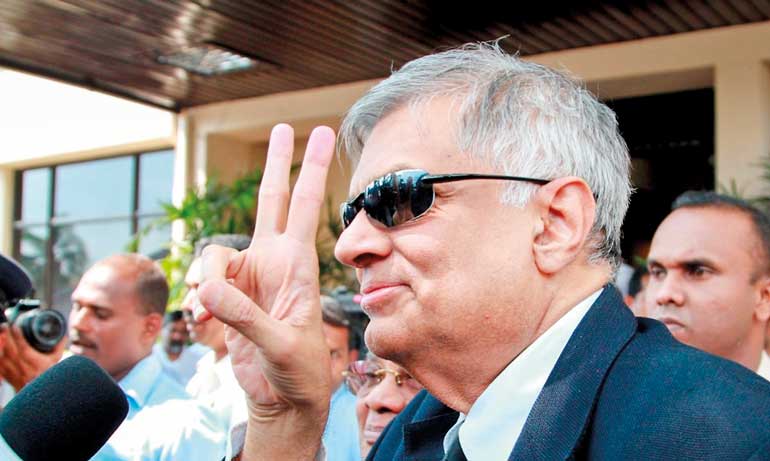Wednesday Apr 24, 2024
Wednesday Apr 24, 2024
Thursday, 28 April 2016 00:00 - - {{hitsCtrl.values.hits}}

Is Prime Minister Ranil Wickremesinghe charting a new ‘middle path’ foreign policy with China, India, Japan, and the United States?
As the US administration in Washington focuses more on Sri Lanka’s transition into democratic governance, China has recently welcomed Prime Minister Ranil Wickremesinghe in Beijing and the two sides have forged ahead with negotiating agreements of strategic importance.
The Prime Minister’s move might seem unexpected to some observers as the island nation was eager to reverse its previously China-dependent borrowing binge after a presidential election in January 2015, where the 10-year incumbent was soundly defeated by over  80% of registered voters. Nonetheless, the coalition-led Colombo administration by President Maithripala Sirisena and Prime Minister Wickremesinghe apparently have not given up on furthering mutually beneficial Sino-Sri Lankan relations.
80% of registered voters. Nonetheless, the coalition-led Colombo administration by President Maithripala Sirisena and Prime Minister Wickremesinghe apparently have not given up on furthering mutually beneficial Sino-Sri Lankan relations.
To properly understand the changing dynamics, the Sirisena administration’s acts must be seen in a broader, ‘Indo-Pacific’ geopolitical and geo-economic context. The increasing dependence of China and India on the maritime trade routes crossing the Sri Lanka-centric Indian Ocean have bolstered their clout in the region even as the United States shoulders the burden of managing these dynamics to maintain the freedom of navigation.
In this precarious situation, Sri Lanka’s geostrategic location and economic gravity make the island an important player, whose actions have overarching repercussions not only in the Indian Ocean-rim countries but also among major powers. The predominantly Buddhist island nation’s ‘Middle Way’ or ‘Middle Path’ acts in a manner that holds the key to win-win collaboration in the dynamic Indo-Pacific region: by adopting a sophisticated foreign policy that avoids excessive inclination to China, India, or America (CIA), Colombo compels these three major strategic stakeholders to put up with each other’s presence in the region.
Following a similar trend, other countries of the Indian Ocean and elsewhere also simultaneously engage with Beijing, New Delhi, and Washington—paving the new road to an ‘Indo-Pacific’ century as if the people and democracy mattered.
The new strategic chessboard
While in Beijing, Wickremesinghe made clear that Colombo is devoted to the ‘freedom of navigation’ in the Indian Ocean. This commitment is crucial in a time when this body of water is emerging as one of the most important highways of international commerce: it hosts commercial waterways, which carry a great proportion of global container and resource transports as well as vast energy and mineral reserves. Moreover, the crucial choke points of global trade—the Hormuz and Malacca Straits as well as the Bab el Mandeb—are also located in this region.
The economies of China, India, and Japan are inseparable from the security of energy flows in the Indo-Pacific. Beijing, for instance, is heavily reliant on the Malacca Strait where more than 80 percent of its energy imports transited through in 2015. China’s efforts of increasing its presence in this economically vital area are manifested in the grandiose ‘One Belt, One Road’ (OBOR) initiative, which aims to better integrate Asia, Africa, and Europe. Although Beijing emphasises ‘win-win’ cooperation under the project’s framework, some observers argue that the 21st Century Maritime Silk Road (‘One Road’) is merely rehashing the so-called ‘String of Pearls’ strategy to Indian Ocean nations through the South China Sea, which has raised concerns in India, Japan, and the United States.
Apart from massive infrastructural lending, Beijing has been building up naval presence in the region as well: China dispatched more than 20 anti-piracy naval missions to the Indian Ocean and has recently set out to construct its first overseas naval installation in Djibouti in the Horn of Africa.
Similar to China, India too has crucial interests in the Indian Ocean, as it depends on Gulf oil to satiate its voracious hunger for resources. Accordingly, India looks at China’s growing clout in the region with wary eyes. New Delhi has been reluctant to publicly endorse the OBOR and it has proposed its own ambitious initiatives instead. Moreover, India has adopted an assertive maritime doctrine that is partly inspired by security grievances related to China’s growing naval prowess in the area.
As it forges ahead with the ‘Pacific Century,’ the US administration has enduring responsibilities in the region extending ‘from the Indian subcontinent to the western shores of the Americas’. With critical security and economic interests in the area, the US is impelled come to grips with the rise of China and India in the Indo-Pacific. The emergence of these two nations creates ‘an uncertain geometry’ in the strategic landscape of the Indian Ocean, as the prospect of a Sino-US-Indian ‘tripartite seagoing entente’ hangs in the balance. In the meantime, the Pentagon is pushing for a ‘network’ defence strategy with Australia, India and Japan.
For now, the outlook for mutually beneficial Sino-US-Indian cooperation might seem bleak as Sino-Indian relations are marred by mutual suspicion and Sino-US military ties are at their nadir due to the constant South China Sea disputes with Indonesia, the Philippines, and Vietnam.
In all this, however, Sri Lanka can lead a way forward to harmonious co-existence in the Indian Ocean community of nations.
The Colombo Consensus 2.0
During the course of its 2,500-year recorded history, this island nation has been balancing between and among powerful countries with alacrity. For a long time, Sri Lanka has relied on international loans, which were provided under the aegis of the condition-bound Washington Consensus of the World Bank and the International Monetary Fund (IMF).
After the Eelam War (1983-2009), Colombo diversified its lenders and the increasingly dictatorial regime of President Mahinda Rajapaksa was attracted to the no-strings attached loans of the Beijing Consensus. During this era, China pushed for large infrastructure development initiatives such as the Hambantota Port, the Mattala Airport, the Cricket Stadium, $1.4 billion Colombo Port City project, and the Lotus Tower. Symbolically, the latter signifies the ancient Buddhist diplomacy between the two countries.
These projects have become the hallmarks of the ‘Colombo Consensus’: Sri Lanka’s seemingly inevitable drift to Beijing’s financial and commercial arms. At the peak of this affinity, President Xi Jinping made a historic visit to Sri Lanka, followed by two Chinese submarine port visits to Colombo harbour in September 2014.
The year-2015 marked the end of this era. The ‘democratic instincts’ of the Sri Lankan people pulled the nation back from the road to autocracy as Rajapaksa lost the presidential snap election in January and failed to return to power during the subsequent parliamentary elections in August. The new coalition government under the practicing Buddhist President Sirisena embarked on the ‘Colombo Consensus 2.0’—a revised, more equidistant (i.e., ‘midway’) foreign policy.
This engagement started with a rebalancing of the dependent relationship with Beijing. The warming relations between Colombo and Washington received an adrenaline shot as leading US officials visited Sri Lanka, including Secretary of State John Kerry and UN Ambassador Samantha Power. In addition, the USS Blue Ridge’s stopover in Colombo indicates that the United States is open for boosting security ties with the island nation in addition to greater economic partnership, democracy promotion, and good governance. Bonds between Sri Lanka and India also took an amicable turn as Sirisena received Prime Minister Narendra Modi during his Indian Ocean tour. Additionally, India maintains strong presence in Sri Lanka as the Indian Oil Company moves ahead with development and renovating projects in Trincomalee, one of the strategic natural harbours in the world.
Nevertheless, geopolitical imperatives and the lack of material support from the West prompted Sri Lanka to avoid the mistake of the previous Rajapaksa regime, and the new government steered clear from aligning itself entirely with the US and India. Following a year-long suspension, the Colombo Port City project—a critical security concern for India—will continue and China has also set up banking services of the Asian Infrastructure Investment Bank in Sri Lanka. Moreover, Wickremesinghe’s fruitful trip clearly shows that Sri Lanka intends to stay within visual range from China.
Apparently, Beijing was more than happy to extend an arm for Colombo once again. President Xi stated that “the Chinese Government only considers Sri Lankan people and its policies and not personalities and political parties when assisting Sri Lanka, and a third party cannot harm the friendship between Sri Lanka and China.”
Still, the two sides were prudent enough to keep other countries’ considerations in mind while re-engaging. In what some regard as efforts of soothing a suspiciously silent India—who has allegedly contemplated pulling out from the Indo-Sri Lanka Economic and Technology Cooperative Agreement—, the Chinese media asserted that Pakistan is a “calamitous” partner in implementing the ‘One Road’.
Moreover, Sirisena emphasises that Colombo’s actions will not threaten other countries and Wickremesinghe was also eager to allay Indian security concerns in his comments while in Beijing. Additionally, Wickremesinghe has consulted with other trade partner countries and reassured the West that Sri Lanka’s ‘midway’ foreign policy is to “trade with all, entangle with none,” as the original foreign policy motto of the United States.
New kind of autonomy: Independent but interdependent
In this way, Sri Lanka assumes an important role in securing the maritime trade routes of the Indo-Pacific. Colombo endeavours to strike a balance in which it accommodates the CIA + Japan powers at the same time, without granting dominance to any of them. By engaging with all of the four major strategic stakeholders, Sri Lanka compels these giants to learn how to deal with each other, trusting that tension creates innovation for good governance and human progress.
Sri Lanka is not the only country that adopts a strategy of this kind. Australia has recently awarded a Chinese company with a deal providing access to the port of Darwin for a 99-year lease. The Obama White House responded to the development with grave concern, as the port lies at a strategically important position from which US and Australian naval activity could be observed. Seemingly, Canberra is not putting all of its eggs in Washington’s basket.
Additionally, despite the fact that Djibouti is going to host a Chinese naval outpost, the country is far from being monopolised by China: Beijing is a latecomer compared to the Americans, French, and Japanese, who already have facilities there. In a similar fashion, the Seychelles hosts a US drone base, inked infrastructure development deals with India, and it is a likely to enhance future nexus for China’s presence on the Indian Ocean.
Therefore, we see the emergence of a new ‘Indo-Pacific’ World Order. In an effort of adapting to the enduring interests of the US as well as to the rise of China and India, the countries of the Indo-Pacific do not take sides, but they engage with the rising and leading economic powers to capitalise on their own interests and to serve their own people. Following the footsteps of Singapore, Sri Lanka shows us that smaller countries are anything but helpless in the evolving great power dynamics. On the contrary, by compelling great powers to accept each other’s presence, they serve as catalysts in the process of building a harmonious regional order in the Indo-Pacific region.
[The writer, a Rajawali senior fellow of the Kennedy School of Government’s Ash Center for Democratic Governance and Innovation at Harvard University, is the author of Peaceful War: How the Chinese Dream and American Destiny Create a Pacific New World Order (2014), Commercial Providence: The Secret Destiny of the American Empire (2010), and Trade for Peace (2009). He served as a Pentagon professor and US diplomat during the Clinton and Bush administrations, and is currently serving as a commissioner to the US National Commission for UNESCO, an appointment by the Obama administration. Dániel Balázs, a graduate student of international relations at Tongji University in Shanghai, is co-author of this article. The views expressed are their own and do not necessarily represent the views of their affiliated institutions or the US Government.]